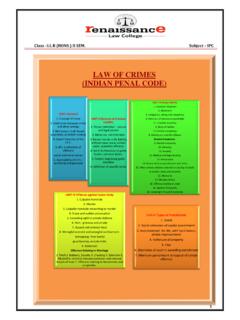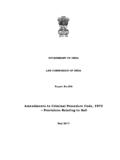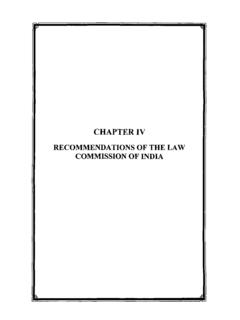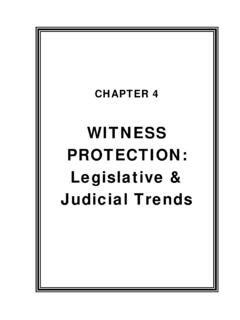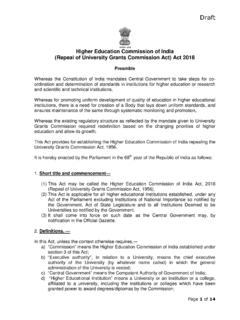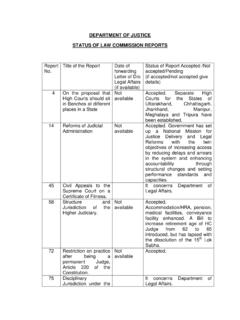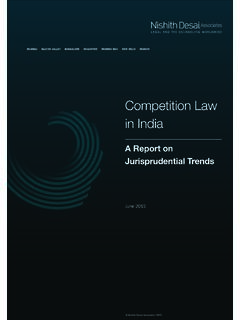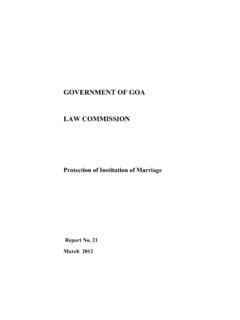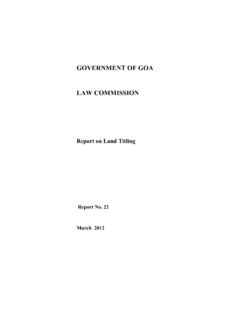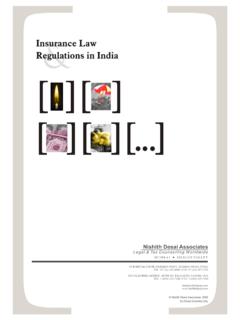Transcription of Competition Laws in India - Kochhar
1 Private and Confidential 1 BANGALORE CHENNAI NEW DELHI GURGAON HYDERABAD MUMBAI ATLANTA SINGAPORE DUBAI JEDDAH RIYADH TOKYO INTRODUCTION OF THE Competition (AMENDMENT) BILL, 2012 IN India : SALIENT FEATURES AND THE IMPLICATIONS THEREOF 3rd Floor, Tower-B, Technopolis Building,Sector-54, DLF Golf Course Road, Gurgaon - 122002, India Tel: +91 124 4545222, Fax: +91 124 4375596 E-mail: Private and Confidential 2 The Competition Act of India ( Act ) was enacted in 2002 as a result of India s pursuit of globalization and liberalization of the economy.
2 Introduction of the Act was a key step in India s march towards facing Competition both from within the country and from international players. The Act is not intended to prohibit Competition in the market. What the Act primarily seeks to regulate, are the practices that have an adverse effect on Competition in the market(s) in India . In addition, the Act intends to promote and sustain Competition in markets, protect consumer interests, and ensure freedom of trade in the market(s) in India . At the heart of the Act are various activities that will be prohibited as being anti-competitive. The activities comprise: (a) Anti-competitive arrangements; (b) Abuse of dominant position; and (c) Mergers and acquisitions that have an appreciable adverse effect on Competition in India .
3 The Act also provides for the establishment of the Competition commission of India ( CCI ), which would function as a market regulator for preventing and regulating anti-competitive practices in the country, as well as a Competition Appellate Tribunal ( COMPAT ) which is a quasi-judicial body established to hear and dispose of appeals against any direction issued, or decision made by the CCI. Private and Confidential 3 In light of the experiences gained in its operation and the working of the CCI, the Government of India , in June 2011, constituted an Expert Committee to examine and suggest modifications to the Act.
4 The amendments, approved by the Cabinet in October, are aimed at fine-tuning the regulations to bring rules on par with the prevailing scenario and in light of the experiences gained over the past years. Accordingly, on 7 December 2012, the Central Government introduced the Competition (Amendment) Bill, 2012 in the Lower House (Lok Sabha) (the Bill ). Typically, a bill has to be passed by both the Houses (Lok sabha and the Rajya Sabha) before it is sent to the President for his assent, pursuant to which, it becomes law. This Article intends to set forth some of the salient features of the Bill, as suggested by the Expert Committee, which seek to amend the existing provisions of the Act.
5 1. Definition of turnover under Section 2(y) Section 2(y) of the Act provides for the definition of turnover . The Bill seeks to exclude the taxes levied on sale of goods or provision of services from the definition of turnover. This definition of turnover is primarily used for determining thresholds for combinations and for imposition of penalties. 2. Inclusion of provision of services under explanation to Section 3(4) It has been proposed that the explanation to Section 3(4) of the Act (which deals with vertical agreements) should be amended to cover the element of services being provided as well.
6 The term services has been defined Private and Confidential 4 under Section 2(u) of the Act and the same is also incorporated under Section 3(4) of the Act, yet the element relating to the provision of services was absent from the explanation to Section 3(4) of the Act. Thus, for instance, an exclusive supply agreement was previously explained as including any agreement restricting in any manner the purchaser in the course of his trade from acquiring or otherwise dealing in any foods other than those of the seller or any other person , it is being proposed to be amended as including any agreement restricting in any manner the purchaser of goods or recipient of services in the course of his trade from acquiring or otherwise dealing in any foods other than those of the seller or any other person.
7 In addition to exclusive supply agreement(s) , the explanation to Section 3(4) also provides for scenarios such as tie-in arrangements, exclusive distribution agreements, refusal to deal, resale price maintenance etc., and the proposed amendment ( inclusion of service element) shall apply equally to scenarios under Section 3(4). 3. Inclusion of collective dominance aspect under Section 4(1) It has been proposed that Section 4(1) be amended with the inclusion of the words joint or singly . Accordingly, the proposed revision of the verbiage of Section 4(1) would be: No enterprise or group, jointly or singly, shall abuse its dominant position.
8 Private and Confidential 5 There has been a lot of discussion as to how this amendment to Section 4(1) would strengthen the position of the CCI and will introduce a new concept that is in line with the position under Article 82 of the EC Treaty. One line of argument is that the opening words of Article 82 of EC Treaty and Section 4 of the Act, as it presently stands, are divergent, in as much as, Article 82 begins with the phrase any abuse by one or more undertakings of a dominant position and it was this phrase one or more undertakings which was used by Court of First Instance in Italian Flat Glass case1 to hold that there is nothing in principle to prevent two or more independent economic entities from being, on a specific market, united by such economic links that, by virtue of that fact.
9 Together they hold a dominant position vis- -vis the other operators on the same market. This marked the birth of the concept of collective dominance in Europe. However, Section 4 of the Act aims at an enterprise or group . Section 4(1) presently reads [N]o enterprise or group shall abuse its dominant position . There is nothing in the definition of enterprise under Section 2(h) or in the provisions of Section 4 to suggest that two or more independent entities can be clubbed together to constitute collective dominance. Having said that, however, in the DTH case2 in 2011, the dissenting member had opined that an enterprise has been defined in Section 2(h) of 1 Judgment of the Court of First Instance (First Chamber) of 10 March 1992.
10 - Societ Italiana Vetro SpA, Fabbrica Pisana SpA and PPG Vernante Pennitalia SpA v commission of the European Communities EUR-Lex-61989A0068 2 Consumer Online Foundation v Tata Sky Ltd & Ors, Case No. 2/2009, Order dated (Dissenting) Private and Confidential 6 the Act as including a person . A [P]erson has been defined under Section 2(l) as including as association persons .. whether incorporated or not .. and thus, the respondents in that case would together constitute an unincorporated association of persons , thereby making them an enterprise for the purposes of Section 4(1) of the Act.

